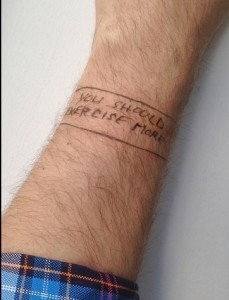November 17th, 2014 by Dr. Val Jones in News, Research
4 Comments »

A Cost Effective Fitness Band
In a new study published in the Annals of Internal Medicine, researchers found that overweight and obese patients who used a popular smart phone app (MyFitnessPal) did not lose significant weight after a 6 month trial period. The randomized controlled trial is the first of its kind to demonstrate that well-liked mobile apps may be ineffective for most users.
Two hundred and twelve racially diverse (73% female) patients treated at two UCLA primary care clinics were enrolled in the study. All indicated that they were interested in losing weight and 79% who completed the study indicated that they were “somewhat” or “completely” satisfied with the app, while 92% reported that they’d recommend it to a friend.
Unfortunately, as pleased as the subjects were with the app, there was no statistically significant difference in weight loss between the intervention and control groups. On average, the MyFitnessPal users lost 0.66 lbs in 6 months.
The authors note:
“Most participants rarely used the app after the first month of the study… Given these results it may not be worth a clinician’s time to prescribe MyFitnessPal to every overweight patient with a smart phone… Our analysis did not show any demographic covariates to be important predictors of app use.”
This study serves as a reminder that “popular” and “effective” do not always go hand-in-hand when it comes to weight loss interventions. While mHealth apps are expected to earn $26 billion by 2017, one is left to wonder if this money will be well spent or if we’ll all be “somewhat to completely satisfied” with the apps without anything medically significant to show for it?
November 13th, 2014 by Dr. Val Jones in Health Tips, Opinion
3 Comments »
 Much has been made about physicians’ tendencies to interrupt patients. Studies have shown that patients are permitted 12-18 seconds of talk time before they are redirected (or interrupted) by their doctor. This leads to patients feeling that the physician didn’t listen or didn’t care. I believe that there is a way to solve the problem without wasting time or being rude. I have used this technique with great success over the years and it works especially well in the inpatient setting, when beginning a formal “history and physical exam.” In three simple words:
Much has been made about physicians’ tendencies to interrupt patients. Studies have shown that patients are permitted 12-18 seconds of talk time before they are redirected (or interrupted) by their doctor. This leads to patients feeling that the physician didn’t listen or didn’t care. I believe that there is a way to solve the problem without wasting time or being rude. I have used this technique with great success over the years and it works especially well in the inpatient setting, when beginning a formal “history and physical exam.” In three simple words:
Physician goes first.
Before I enter the patient’s room, I perform a careful review of their medical records and imagine what it must have been like for them to experience the events leading up to our meeting. I reconstruct the emotional time line in my head and figure out which pieces of information I need to complete my assessment and plan. Then when I meet the patient (often for the first time) I begin by greeting them warmly and then telling them what I have gleaned from their medical records, and how I think they may have felt during the process leading up to their hospitalization. This establishes that I have taken the time to get to know their background, that I genuinely care about how they’ve been dealing with things emotionally, and that I am determined to correct the record if there are any gaps or errors. I then rely on the patient to fill in the details or clarify results that are unclear.
This strategy saves the patient from having to review historical information that the physician already knows about (which usually leads to the classic interruption at second 12-18 of the interaction), and provides structure for patient participation and input. It establishes trust with the new physician, and conveys empathy. It corrects the medical record when necessary, and maximizes the efficiency of the information exchange. To drive home the concept, let me provide you with two hypothetical conversations with “Mrs. Smith” – in the first case the physician will approach her in the traditional manner, and in the second, with the “physician goes first” method.
Establishing the “chief complaint” with Mrs. Smith – Traditional method
Dr. Jones: (entering hospital room where Mrs. Smith is sitting alone in her bed in no acute distress): “Good morning, Mrs. Smith. I’m Dr. Jones, the attending physician for this unit. What brings you here today?”
Mrs. Smith: (eyeing Dr. Jones with some degree of confusion). “Well, I just had surgery, and I guess I’m still a bit weak so they said I needed to come to rehab but I still don’t really understand why I had to change rooms. Did you know I had surgery? Yes, I was walking my dog on the sidewalk and he pulled a little too hard to lurch at a squirrel and the next thing I knew I was on the ground and my hip was hurting and I was all scraped up and I saw this man in the distance who started running towards me and then I think I passed out and when I got to the hospital, I don’t know, they were worried I had a seizure and then they did a CAT scan and then when I….”
Dr. Jones: “I see. But what I need to know from you now is what is your chief complaint. In other words, why are you here in the rehab unit?”
Mrs. Smith: “Well aren’t you the doctor? You’re supposed to tell me what to do when I’m here aren’t you?”
Dr. Jones: “Yes, of course. But I was hoping you could tell me in your own words.”
Mrs. Smith: Sighs heavily. “Well, I’m here because I fell down and broke my hip and then they found out that I hit my head too and then I guess they were trying to figure out if they needed to put a drain in or just give me seizure pills and I’m not sure how they decided but I don’t remember a drain so I guess… Isn’t all this in my records somewhere? Can’t you figure out what happened?”
Dr. Jones: “Yes, it’s all in your chart but…”
Mrs. Smith: “Well then why don’t you just read it instead of asking a poor old lady with a bad headache to tell you what happened all over again. Everyone keeps asking me for the same old story and I’m just so tired…”
Dr. Jones: “So you’re here in rehab because you’re tired?”
Mrs. Smith: “Well, I guess that’s it.”
Establishing the chief complaint with Mrs. Smith – “Physician goes first” method:
Dr. Jones: “Hello Mrs. Smith, I’m Dr. Jones, the rehab physician who will be taking care of you on this floor. I read through your chart very carefully and learned that you fell down on the sidewalk when walking your dog about a week ago. It looks as if you broke your hip as well as hit your head during the fall. I see that you had your hip repaired surgically, and that fortunately you didn’t need any treatment for your head injury because it didn’t bleed very much internally, but as a precaution you were given some anti-seizure medicine. I imagine that this sudden hospitalization was an unwelcome surprise for you – there you were just walking your dog on a normal day, minding your own business and whammo – now you’re here in the hospital with me!? Well, my goal is to get you back home as soon as you’re ready and steady enough. What is your main goal for rehab?”
Mrs. Smith: “Yes, well it certainly was a shock to get the wind knocked out of me. You hear about little old ladies falling down and breaking a hip but I never thought it could happen to me. Now all I need to do is be able to walk safely so I can go home.”
Dr. Jones: “Well, the good news is that you were very active prior to your fall so I bet you’ll do very well here because you have a good baseline fitness level. My goal is to help control your pain so you can make the fastest gains possible. I bet your hip bothers you and you may have headaches too.”
Mrs. Smith: “Yes, well that’s just it. I’m in quite a bit of pain when I stand up but I’m afraid of becoming a drug addict so I try not to take the pills…”
As you can see, the second conversation was much more successful in establishing a relationship with the patient and getting to the meat of what the doctor needs to know (the patient’s primary goal, her pain level, and what the barrier to treatment might be) without the frustration caused by traditional “open ended questions” and lack of structure – leading to interruptions and perceived lack of caring on the part of the physician.
In my experience, doing a little up front chart review and taking the lead in the first patient encounter results in a dramatic decrease in wasted time and need for redirection. So in the case of avoiding rude patient interruptions – taking the conversation lead may be the best bet.
This is an unusual case where putting the patient first involves letting them talk second.
November 6th, 2014 by Dr. Val Jones in Opinion, Research
No Comments »
 I have spent many blog hours bemoaning the inadequate communication going on in hospitals today. Thanks to authors of a new study published in the New England Journal of Medicine, I have more objective data for my ranting. A prospective intervention study conducted at 9 academic children’s hospitals (and involving 10,740 patients over 18 months) revealed that requiring resident physicians to adopt a formal “hand off” process at shift change resulted in a 30% reduction of medical errors.
I have spent many blog hours bemoaning the inadequate communication going on in hospitals today. Thanks to authors of a new study published in the New England Journal of Medicine, I have more objective data for my ranting. A prospective intervention study conducted at 9 academic children’s hospitals (and involving 10,740 patients over 18 months) revealed that requiring resident physicians to adopt a formal “hand off” process at shift change resulted in a 30% reduction of medical errors.
What was the intervention exactly? Details are available via mail order from the folks at Boston Children’s Hospital. It may take me a few weeks to get my hands on the curriculum (which was supported by a grant from the Department of Health and Human Services). I’m not sure how complex the new handoff initiative is in practice (or if it’s something that could be replicated without government-approved formality) but one thing is certain: disciplined physician communication saves lives.
I myself (without a grant from HHS or a NEJM study to back my assertions – ahem) proposed a set of comprehensive communication practices that can help to reduce medical errors in the hospital. My list involves more than peer hand-offs, but also nursing communication, EMR documentation strategies, and reliance on pharmacists for medication reconciliation and review. It is more than just an information exchange protocol for shift-changes, it is a lifestyle choice.
I applaud the I-PASS Handoff Study for its rigorous, evidence-based approach to implementing communication interventions among pediatric residents in children’s hospitals. I am stunned by how effective this one intervention has been – but a part of me is saddened that we practically had to mandate the obvious before it got done. What will it take for physicians to adopt safer communications strategies for inpatient care? I’m guessing that for many of us, it will involve enrollment in a workshop with hospital administration-driven requirements for participation.
For others of us – regular communication with staff, patients, and peers already defines our medical practice. But because (apparently?) we are not in the majority, we’ll just carry on our instinctual carefulness and wait for the rest to catch up. At least now we know that there is a path forward regarding improving communication skills and transfer of patient information. If we have to force doctors to look up from their iPhones and sit around a table and speak to one another – then so be it. The process may improve our lives while it saves those of our patients.
November 3rd, 2014 by Dr. Val Jones in Health Tips, Opinion
214 Comments »
 Most hospitalized patients and families don’t realize that life-threatening medication errors are regularly thwarted by pharmacists. They are truly the unsung heroes of patient care. I just finished a locum tenens assignment at a hospital that uses EPIC as their electronic medical records system, and I was stunned by the impossibly complex medication reconciliation process. Each time a patient is admitted to the hospital, or transferred to another part of the hospital, a physician must review, approve, and re-order their medications. While this may seem like a good way to insure that medication errors are avoided, it actually has the exact opposite effect.
Most hospitalized patients and families don’t realize that life-threatening medication errors are regularly thwarted by pharmacists. They are truly the unsung heroes of patient care. I just finished a locum tenens assignment at a hospital that uses EPIC as their electronic medical records system, and I was stunned by the impossibly complex medication reconciliation process. Each time a patient is admitted to the hospital, or transferred to another part of the hospital, a physician must review, approve, and re-order their medications. While this may seem like a good way to insure that medication errors are avoided, it actually has the exact opposite effect.
Because EPIC keeps lists of home meds, discontinued meds, and current meds available for review and reactivation, it takes little more than one misplaced check box to order the wrong dose or type of medication. Physicians who transfer a patient to another service can indicate their intended medication list and keep it “on hold” for the receiving physician to review and approve. Unfortunately, the software’s tab system is so complex that it’s extremely difficult to find that list and activate it. Lost in a sea of admissions tasks and order boxes in different fonts, colors, and drop down menus, one often accidentally reviews and approves discontinued types and doses of medicines. The only protection against such errors is the hospital pharmacist.
With each new admission to the inpatient rehabilitation unit, I had to resort to calling a pharmacist for help. I was terrified that I would accidentally insert medication errors into the patient’s order set by carrying forward discontinued meds. The long-suffering pharmacists explained to me that “most physicians make medication order errors in EPIC with each admission.” They said that they regularly had to talk physicians out of throwing their computer out the window in a state of extreme frustration. They also said that their EPIC user environment looked very different (and less confusing) than what the physicians used, so that they couldn’t even provide real-time phone guidance regarding order entry process.
The scary thing is that EPIC has the largest market share of any EMR in the United States. It is also (in my experience) the most prone to medical errors due to its overly complex medication reconciliation process. I have used other EMRs that have far simpler and more intelligent medication order entry processes. Soarian (Sieman’s EMR, just sold to Cerner) has, for example, an outstanding order entry system. So my complaint is not that “all EMRs are bad” – it’s that some have particularly flawed designs that are causing real harm to untold millions of patients. We just haven’t documented the harm yet. I tremble at the thought of what we’d find.
Until electronic medication reconciliation is made safer, pharmacists will be working overtime to correct records and protect patients from carry over errors. I thank my lucky stars that I have had vigilant, determined pharmacists by my side as I cared for very complex, sick patients who were exceptionally vulnerable to dosing errors. There has never been a more important time to exercise caution when entering hospital medication orders, or to express your appreciation for pharmacists. Without their help we might all be experiencing medication errors of EPIC proportions.



 Much has been made about physicians’ tendencies to interrupt patients.
Much has been made about physicians’ tendencies to interrupt patients.  I have spent
I have spent  Most hospitalized patients and families don’t realize that life-threatening medication errors are regularly thwarted by pharmacists. They are truly the unsung heroes of patient care. I just finished a
Most hospitalized patients and families don’t realize that life-threatening medication errors are regularly thwarted by pharmacists. They are truly the unsung heroes of patient care. I just finished a 







